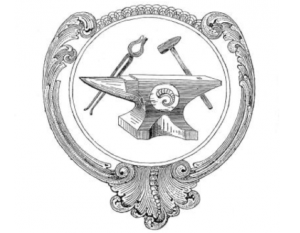Of all the ironwork I have seen in this country, this fine Baroque style gate stands to be one of the finest installations, as it is truly exceptional in many aspects. I happened upon this while researching an unrelated prospect about eight years ago, with an interior designer south of
These are images from a repair job for a client whose iron fence had been struck by a car. The fence was made by Cyril Colnik. Repairing and restoring vintage ironwork has many rewards and also some surprises. In this case, the surprise was how Colnik solved a joint problem
The following images, in a chronological format, show some of the decorative sign brackets I have made over the years. All are hand-forged, with the exception of the “Toldt Woods” sign, and parts of the “Carroll College” archway. The image below of the “Faces II” bracket was not only my
Continuing with the liturgical aspects of decorative ironwork……… This Grave Cross was one of several pieces I restored for a client in southeastern Wisconsin. This collection of ironwork is extraordinary in that most of it is of a distinct European flavor, spanning several styles and applications. The exciting aspect to
This is the second installment of master blacksmith Cyril Colnik’s liturgical ironwork from my archives. Unfortunately, these images have no indication on them as to where these pieces were installed. The image above shows several fine pieces; candlesticks, a prie-dieu (prayer kneeler), *, and what appears to be an eternal
“Reproduction Chandelier” , 2004, mild steel, black Gilders paste finish Two of the installations in this blog have dealt with repoussé elements applied to a reproduction of a Cyril Colnik chandelier, made for the “Captain Frederick Pabst Mansion” back in 2004. (See above image.) In this installment, I would like
“Candlestick 2005.” 6 1/2″ x 12″, mild steel, black Gilders Paste finish. Photo by George Lottermoser. There are different processes of repoussé, as explained in an earlier discussion here. Today we will take a closer look at the process of sinking. The below-story board shows the development of a bobeche,
Cyril Colnik (1871-1958) was born in Triebein, Austria on September 20th, 1871. He traveled Europe as a journeyman, and later enrolled in to the Munich Indiustrial Art School. Germany adopted him, and sent him to help with their ironwork exhibit at the 1893 World’s Columbian Exhibition in Chicago. It is
After forging decorative and architectural ironwork for over 30 years, there seems to be no end to design possibilities in sight. The thrill of discovery, of new forms, of yet untried motifs, has me returning to the drawing board, and consequently to the fire with anticipation. This is the stuff
French repoussé, also called “hammer and stake raising”, is one of several repoussé processes. This method utilizes several small raising hammers, that lightly strike the sheet metal over various stake forms held in a vise. Another process involves “sinking”, by using various punch-like forms to force the sheet metal into
